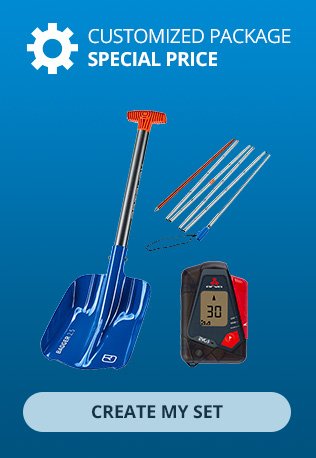Touring bindings
Enjoy great deals on the best ski touring gear with a selection of bindings from leading manufacturers such as Dynafit, Marker, Fritschi, Atomic, Plum, Salomon, Look, G3, ATK, Armada, Rossignol, and more. Don't forget accessories like crampons to avoid tricky situations when you encounter hard snow, but keep in mind that they cannot replace real crampons on steeper slopes or ice.
Read more Show less

-
Recommended price
£304.50
-25%
£226.20
The Atomic N Backland Summit 9 Lsh ski binding is ideal for ski touring enthusiasts. It offers a DIN adjustment range from 4 to 9, adapting to a wide variety of skiers and snow conditions. It features the AutoFlex system, which ensures 4 mm elasticity providing natural flexibility and added safety. Robust and lightweight, it is designed to offer optimum performance in the mountains while guaranteeing skier safety.
Loading...
Which Ski Touring Binding Should You Choose?
Based on a rigorous selection of touring bindings, Glisshop helps you make the right choice from top brands according to your skiing style. An essential element, touring bindings require proper adjustments, particularly in terms of the release value, to ensure your ski boot stays secure and keeps you safe in case of a fall. To help you check the compatibility between your bindings and boots, check out our page on ski boot sole and binding standards. If you have any doubts, our experts are available via chat or phone to help you choose ski touring bindings and find the best model for your needs.
Ski Touring and Freetouring Bindings
Just like in alpine skiing, ski touring bindings are a safety component designed to protect skiers from injuries, particularly joint trauma. However, touring bindings must also facilitate uphill travel while securing downhill skiing. Depending on whether your focus is touring or freeride, your criteria will differ. If your goal is to gain as much uphill elevation as possible, a lightweight model like the Marker Alpinist will be ideal. For aggressive freeride skiing, you’ll want to ensure the maximum release value is high enough. Here is an overview of the three categories of touring bindings to help you make your choice:
Alpin Touring (AT) or Frame Bindings (the closest to alpine bindings)
Very similar to alpine bindings, frame bindings can release the boot like standard bindngs and feature heel lifts and, in some cases, ski brakes. They can be used with standard ski boots, but they are the heaviest touring bindings, best suited for short or occasional tours. Freeriders will appreciate them for reaching difficult-to-access areas, though the weight of the wide skis combined with these bindings won't take them very far uphill. Frame bindings offer a safety advantage in case of falls, releasing similarly to alpine ski bindings. They also offer a wide range of adjustment for boot length.
Low Tech Bindings or Pin bindings (Dynafit Speed, Plum Guide, or Marker Alpinist)
Specific to ski touring, Low Tech (LT) bindings are only compatible with ski boots designed for touring that have inserts. Holes are drilled on either side of the front of the shell, into which the toe piece’s metal pins lock. The minimalist toe piece generally offers only two positions: walking mode, which locks the binding and prevents losing the ski when skinning, and ski mode, which allows for release during the descent based on the heel piece's adjustable tension. Some models in this category can be fitted with ski brakes.
Hybrid Ski Touring Bindings (Atomic N Shift, Salomon N S/Lab)
Halfway between Low Tech and frame bindings, hybrid bindings aim to combine the lightweight advantage of touring pin bindings with the safety of traditional alpine bindings. To ensure a release similar to alpine ski bindings, the heel piece now includes ski brakes and a lever system activated by the skier’s heel. Marker pioneered this technology with its Kingpin model in winter 2015, and continues to showcase its expertise with the latest generation hybrid low tech binding, the Duke PT. Salomon, Atomic, and Armada also offer excellent options in this field, and we highly recommend them.
What is the Weight of Different Bindings?
The advantage goes to Low Tech bindings: at an average of 700 g per pair, it’s hard to find anything lighter. However, this comes at a cost in terms of safety, as there are no ski brakes, just a leash connecting the ski to the boot, and a smaller range of adjustment. For example, the Marker Alpinist 8 weighs just 490 g per pair. Hybrid bindings weigh around 1.5k g per pair, while frame bindings can reach up to 3 kg. Weight is an important factor to consider when choosing the right category of touring bindings for your needs.
Choose Your Ski Touring Binding Based on Your Skiing Style
Each discipline of skiing (mountaineering, touring, or freeride) requires a binding adapted to the skier's specific needs.
With the growing popularity of ski touring in recent seasons, brands are focusing heavily on developing technologies that provide lighter and more efficient bindings, offering greater safety with greater adjustment ranges for release values.
Glisshop Tips:
- Accurately assess your skill level to choose a style that suits your physical condition and technical abilities.
- Decide on your priority before choosing your binding: uphill lightness, downhill performance, safety, etc.
- Feel free to contact our experts, who will be happy to help you choose the right bindings or any other piece of ski equipment.



